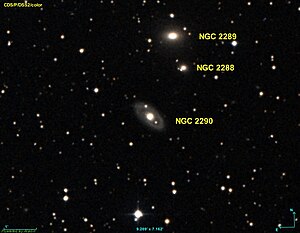NGC 2290
| Galaxy NGC 2290 |
|
|---|---|

|
|
| AladinLite | |
| Constellation | Twins |
|
Position equinox : J2000.0 , epoch : J2000.0 |
|
| Right ascension | 06 h 50 m 56.9 s |
| declination | + 33 ° 26 ′ 15 ″ |
| Appearance | |
| Morphological type | (R) SAa |
| Brightness (visual) | 13.3 mag |
| Brightness (B-band) | 14.2 mag |
| Angular expansion | 1.2 ′ × 0.7 ′ |
| Position angle | 50 ° |
| Surface brightness | 13.0 mag / arcmin² |
| Physical data | |
| Affiliation | LGG 139 |
| Redshift | 0.016822 ± 0.000030 |
| Radial velocity | (5043 ± 9) km / s |
|
Stroke distance v rad / H 0 |
(225 ± 16) x 10 6 ly (68.9 ± 4.8) Mpc |
| history | |
| discovery | Wilhelm Herschel |
| Discovery date | February 4, 1793 |
| Catalog names | |
| NGC 2290 • UGC 3562 • PGC 19718 • CGCG 175-019 • MCG + 06-15-012 • 2MASX J06505690 + 3326154 • GC 5369 • H III 897 • LDCE 0468 NED008 | |
NGC 2290 is a spiral galaxy of Hubble type Sa in the constellation Gemini on the ecliptic . It is an estimated 225 million light years from the Milky Way .
The object was discovered by Wilhelm Herschel on February 4, 1793 .
